How to Season Cast Iron Pans
How to season cast iron pans is a simple step in creating a non-stick surface for the best cooking experience. Cast iron is an heirloom that can last for generations when proper care is maintained.

How to Season a Cast Iron Skillet
Cast iron is my favorite kitchen staple for cooking and baking. I make crispy sweet potatoes, pan-fried chicken tenders, cornbread, and even a homemade blueberry crisp dessert.
A cast-iron skillet is one of the best investments you can make for your kitchen. Cast iron skillets are the most versatile and safe cookware, from cooking on the stovetop to baking in the oven.
Here is the ultimate guide I use in my kitchen to season cast iron pans.
Why Cast Iron?
- Versatile: from the stove top to the oven and even a campfire, you can cook nearly anything in cast iron, making it the most versatile cookware.
- Heirloom Quality: from one home cook to the next, cast iron cookware can last for years, being passed down through generations.
- Non-Stick Seasoning: The most beautiful thing about cast iron cookware is the non-stick surface making it easy to cook and clean.
Here are some valuable resources to keep in mind when cooking with cast iron cookware:
- How To Store Cast Iron Pans
- How To Clean Cast Iron Skillet After Use
- How To Clean Enameled Cast Iron
What is Cast Iron Seasoning?
Seasoning is a hard, protective coating baked into the cast iron skillet by heating a thin layer of oil (fat). With regular use, the cast iron skillet builds up a non-stick surface that makes it easy to cook foods in and simple to clean.
The surface of cast iron cookware is bumpy and porous. The thin coat of oil bakes into the iron when the pan is heated, filling in the imperfections and creating a smooth surface.
This chemical reaction is known as polymerization, and over time, layers of seasoning build up, creating a non-stick coating that is commonly referred to as the pan’s “seasoning.”
The more you cook in a cast-iron skillet, the better seasoned it will become, giving the cookware that beautiful black patina with a non-stick cooking surface.
How to Season a New Cast Iron Skillet
Most new cast iron skillets come labeled pre-seasoned, meaning that the manufacturer has already baked at least one layer of seasoning on the pan.
However, I almost always season a new cast iron pan at least once or twice before using it for the first time. The purpose of seasoning cast iron is to protect the surface, making it non-stick.
When to Season Cast Iron Cookware
Cast iron may need to be seasoned if it has lost some of the beautiful black glossy sheen and food begins to stick to the pan. A few common ways to know if cast iron needs to be re-seasoned is by seeing rust spots or dry, dull patches.
The cooking oil helps build a durable protective layer when using cast iron. It may never have to be re-seasoned if you take great care of the skillet and often cook with it.
Supplies for Seasoning Cast Iron Cookware
This post contains affiliate links; this means that I make a tiny commission off any purchase that you may make. This small commission helps keep Rocky Hedge Farm going at no additional cost to you. Please see my disclosure policy for more information.
You can find my favorite kitchen essentials can be located in my Amazon storefront. While I often try to link to the exact products you see in my photos and videos, my pieces are usually vintage and thrifted. However, I try to find and link replicas as much as possible, made in the USA or by other small shops, as I believe in supporting hardworking American families.
- Soap
- Water
- Cooking Oil
- Paper Towels
- Cast Iron Pan Scraper: This scraper tool is great for cleaning and scraping the build-up of food that can occur on a new cast iron skillet.
- Chainmail Scrubbing Pad: another option for removing food build-up off your cast iron pans.
- Steel Wool: If restoring an older cast iron skillet with rust, steel wool is a great option to remove the rust.
- Oven Mitt
- An Oven
How to Season Cast Iron In Oven
After some time, your cast iron skillet may eventually lose the shiny black sheen, and food may begin to stick to the surface.
It is easy to bring back the shine and the non-stick surface with a few simple steps. Here is the easiest way to season cast iron skillet cookware in the oven.
Step 1: Preheat the Oven
Preheat the oven to 450 degrees Fahrenheit.
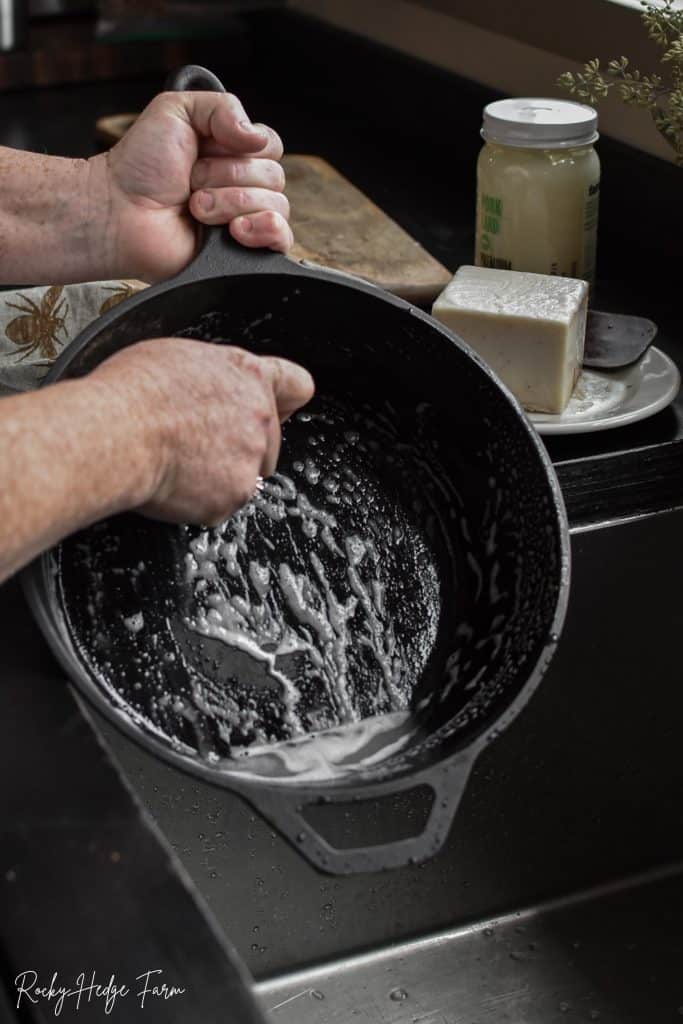
Step 2: Wash and Dry Your Pan
You have probably heard that you should never use soapy water on a cast-iron pan; however, it is okay to use a little soap when getting ready to re-season a cast-iron skillet.
To create the smoothest surface possible, use soap, hot water, and a brush to scrub the entire pan. Use a chainmail scrubber or pan scraper to remove small food particles on the surface.
If the pan has any rusty spots, use steel wool to remove all rust spots creating a clean pan.
Dry the skillet well with a paper towel or kitchen hand towel to remove all lingering water droplets.
To ensure no surface moisture remains, the skillet can be placed on the stovetop for a minute or two, which will completely dry off any excess water.
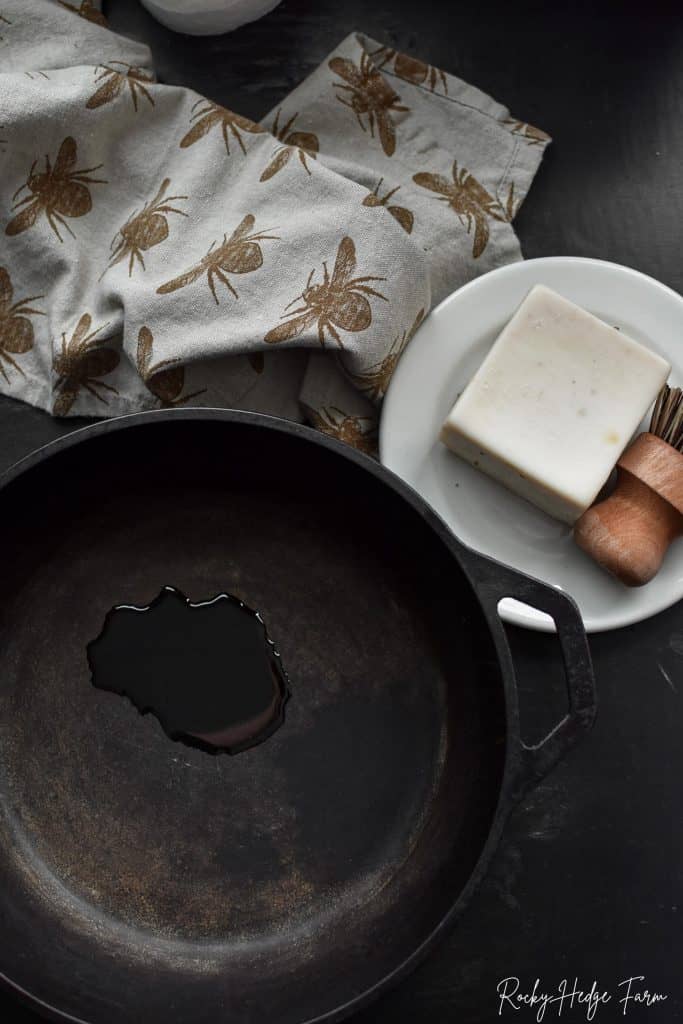
Step 2: Rub With Seasoning Oil
Once the pan is clean and dry, rub it all over with cooking oil—Rub the inside and out and the handle.
I recommend using Organic, Cold-Pressed Grapeseed Oil or Organic Linoleic Sunflower Oil; it is essential to remember to use an oil with a higher smoke point.
Add a small amount of oil to the skillet, and using a paper towel, coat the whole surface. The entire pan, including the top, bottom, sides, and handle, should have a thin coat of oil.
Continue to rub the oil in, removing any excess oil. It takes a minimal layer of oil to re-season the skillet.
Step 3: Heat It in the Oven
Put the oiled skillet upside down on the middle rack in the preheated 450°F oven for 30 minutes. If you are concerned about oil drips, place a baking sheet or a piece of aluminum foil under the cast iron to catch any possible drips.
Step 4: Repeat
When the half-hour is up, use oven mitts to take the cast iron pan out of the oven. Rub it once more with oil as in step 2 and place it back in the oven for another 30 minutes. Once finished, turn the oven off and cool with the door closed.
You should have a new pan with a polished, non-stick black surface at the end of the simple process. It is now seasoned and ready for cooking.
For simple tips on storing your cast iron skillets, check out my guide, How to Store Cast Iron Pans.
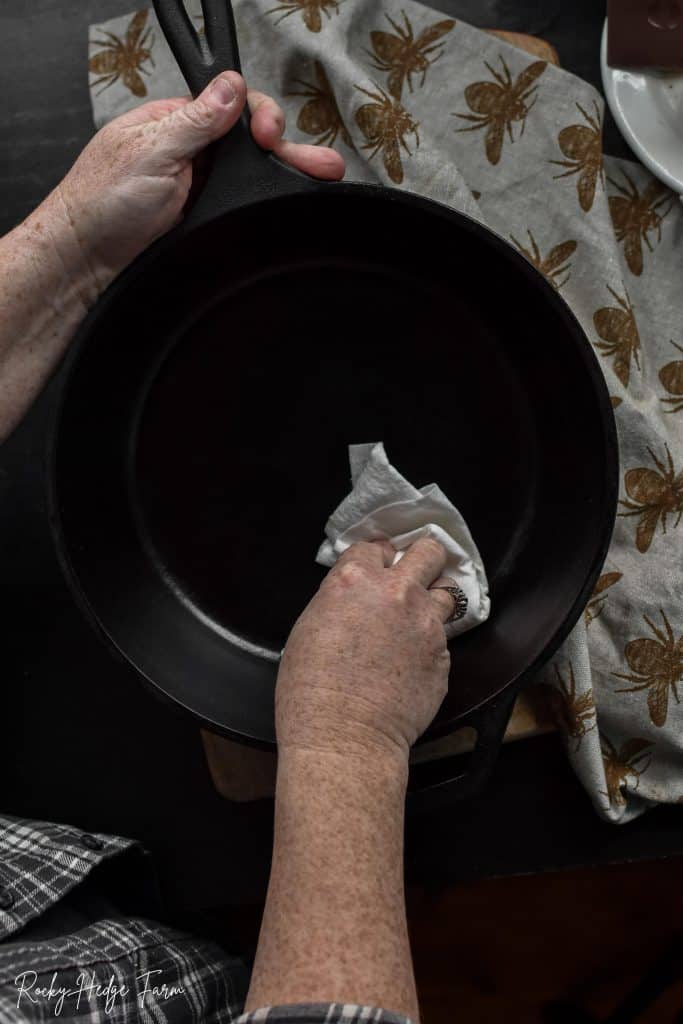
Best oil For Seasoning Cast Iron
Search the internet for the best oil for seasoning cast iron, and you will likely find a wide range of opinions. For the best cast iron seasoning oil, specific oils will give a better coating than others.
For the best results in seasoning, you want one high in polyunsaturated fats such as organic, cold-pressed grapeseed oil and organic linoleic sunflower oil, which are the best oils to season cast iron skillet cookware.
Other options for the seasoning process include vegetable oil, olive oil, and canola oil. Another option is to use flaxseed oil; however, it is a drying oil. The seasoning it produces can be crispy and apt to flake.
Animal fats like lard, bacon grease, butter, and coconut oil are high in saturated fats and won’t produce a good seasoning.
However, these are great options to cook with and are beneficial as a post-cleaning finish to protect your cast-iron cookware.
This will keep the skillet in good shape with regular use, preventing the need to re-season.
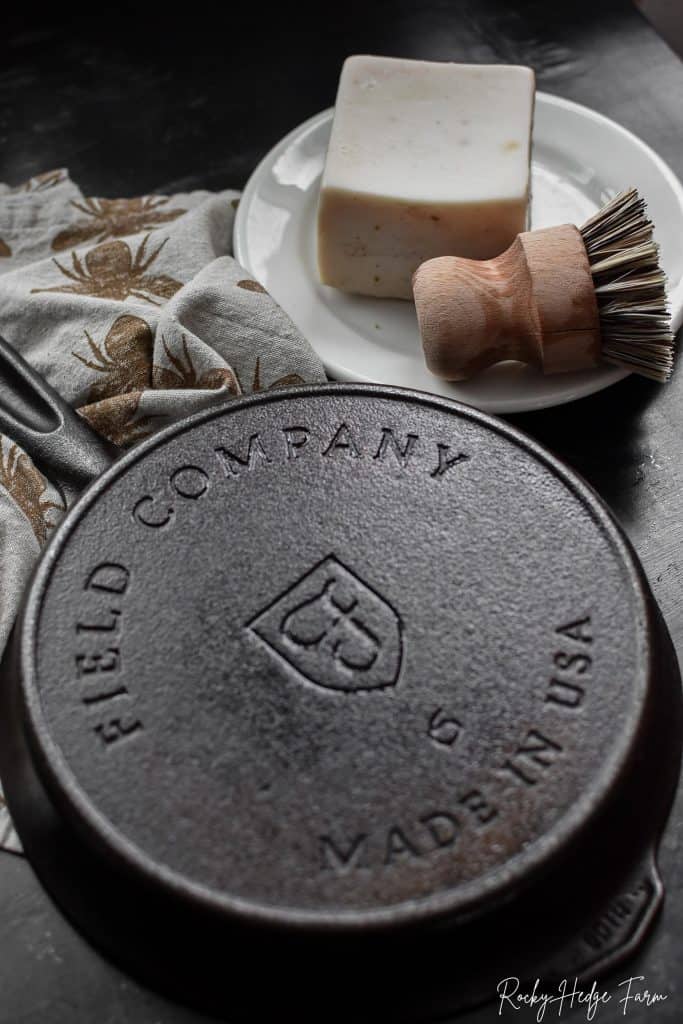
Best Way to Season Cast Iron
The best way to season cast iron pans is to use them daily. Some people believe that cast iron is high-maintenance and requires seasoning repeatedly.
This thought is not valid, and most generally, the only time mine is seasoned is when they are brand new.


Frequently Asked Questions
What Temperature to Season Cast Iron?
The best cast iron seasoning temperature for cast iron skillets is 450 degrees Fahrenheit. Put the oiled skillet upside down on the middle rack in the preheated oven for 30 minutes.
How Often to Season Cast Iron?
To preserve a nonstick surface on your cast iron skillet, it should be re-seasoned twice a year. Using your cast iron skillet often and cleaning it correctly will help to keep your skillet in adequate condition.
If cooking with highly acidic foods or damage is caused by too much abrasion, you may need to reseason cast iron more frequently.
How to Season Cast Iron Without Oven
Seasoning a cast iron skillet without an oven is an easy process. Here is how to season cast iron on stove.
- Heat the cast iron skillet over medium-high heat until the skillet is very hot.
- Take several layers of papers towel and soak them with your preferred choice of seasoning oil. Use a pair of tongs to hold the paper towel to rub the oil in.
- Rub the paper towel for several minutes, ensuring the oil is absorbed.
- Allow the skillet to dry on the stovetop.
- Continue repeating the process until the cast iron skillet looks smooth, dark, and shiny.
- Let the cast iron skillet cool entirely before storing.
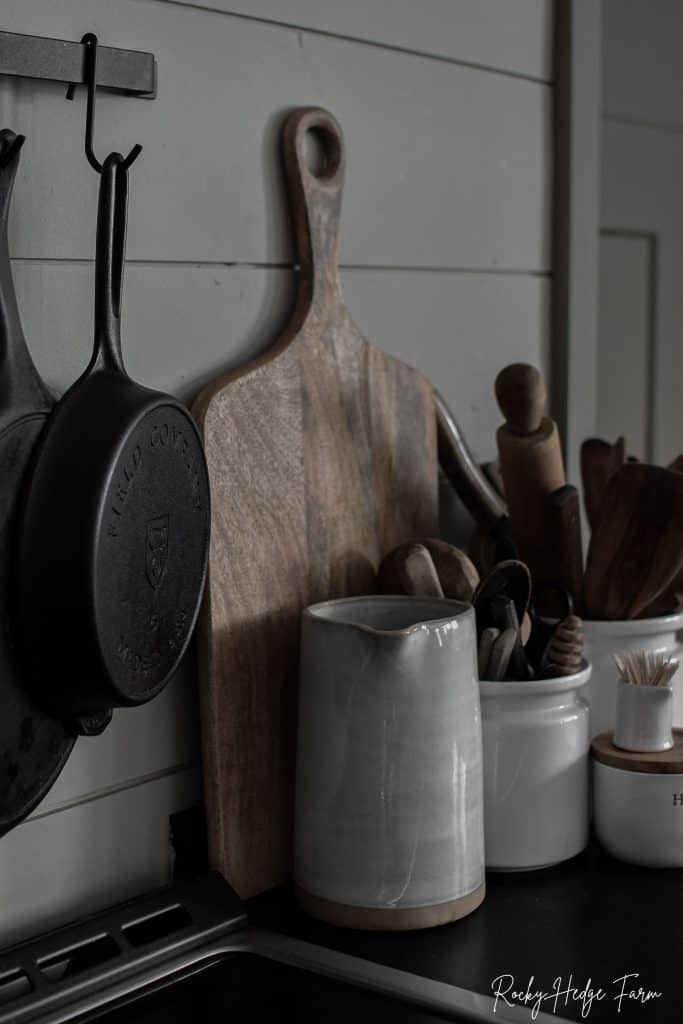
How Long to Season Cast Iron
Typically, season a cast iron pan for about an hour. Seasoning the skillet in a preheated 450°F oven for 30 minutes is done at least twice to season the pan properly.
How Much Oil to Season Cast Iron?
To season your cast iron cookware, use a clean paper towel and rub about 1/8 teaspoon of oil onto the surface of the pan. Start with a bit more oil than necessary to ensure even coverage.
Once you have done that, use a fresh paper towel to wipe away any excess before seasoning the pan in the oven.
What Oil to Season Cast Iron?
For the best oil to season cast iron, use oils rich in polyunsaturated fats. Opt for organic, cold-pressed grapeseed oil and organic linoleic sunflower oil to season your cast iron skillet cookware.
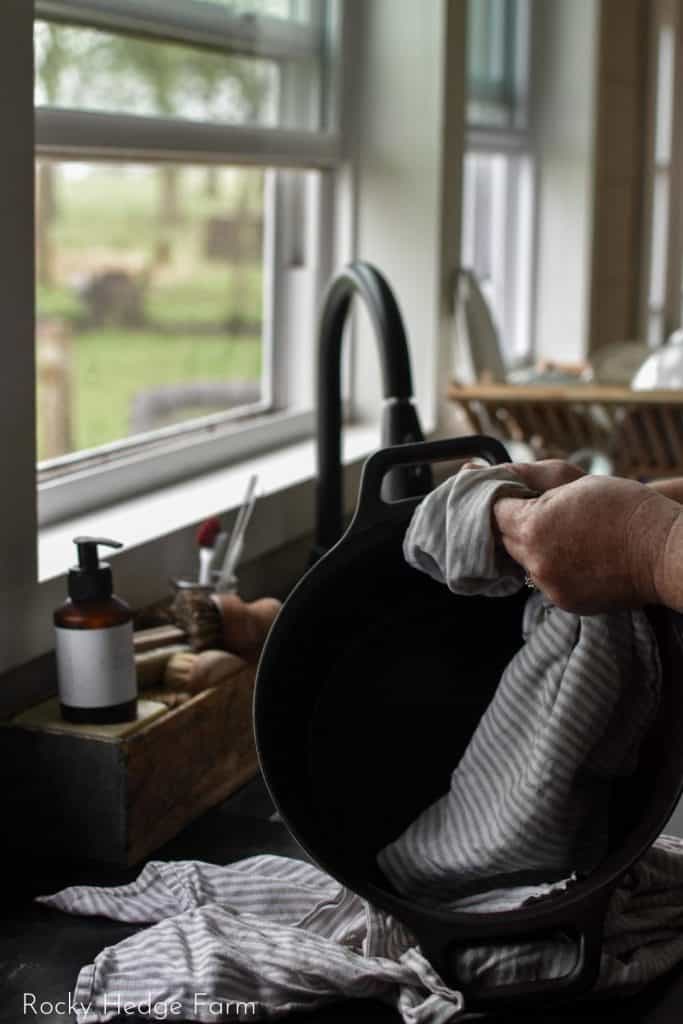
Seasoned Cast Iron Skillet
A well-seasoned cast-iron skillet is a well-used cast-iron skillet. Every time you cook in it with some fat, it builds a new layer of seasoning.
Using cast iron frequently keeps the skillet in excellent working condition that will last for generations.
So, now that you know how to season cast iron pans, you can get busy cooking in your skillet!
Fry some bacon, make homemade sausage gravy or cook a delicious breakfast scramble. You may find that you rarely need to season cast iron skillet cookware with some good care.

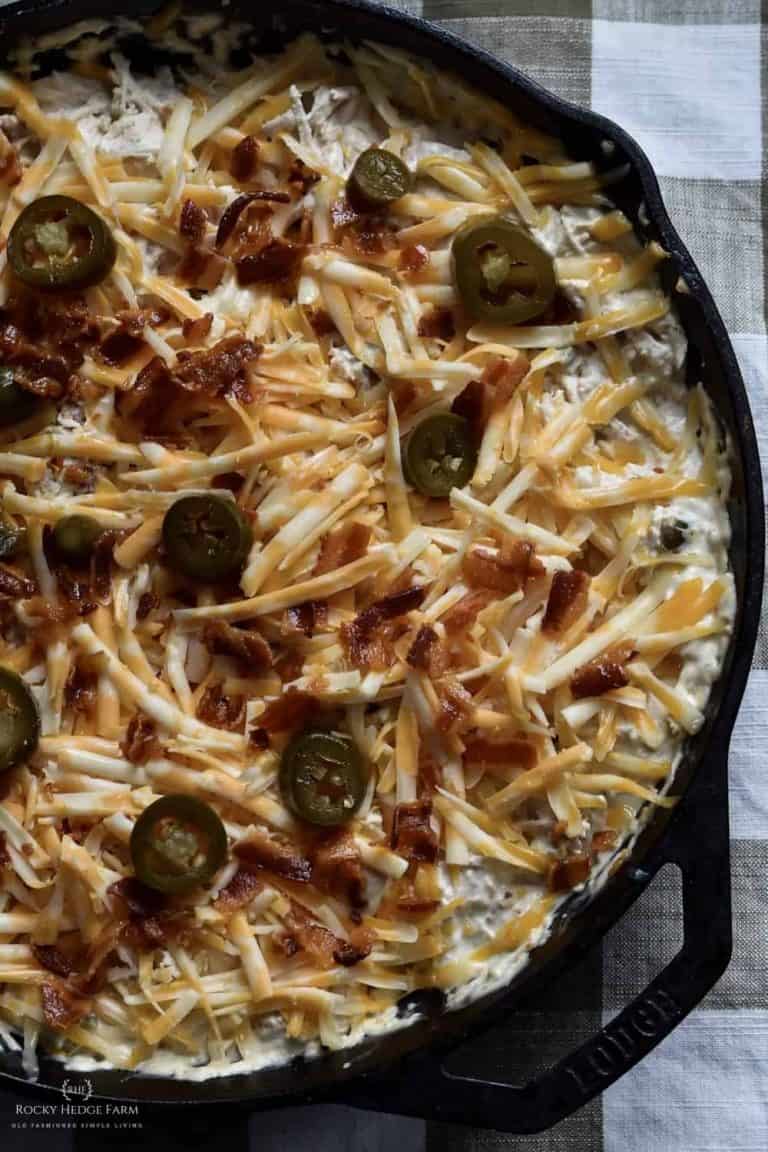


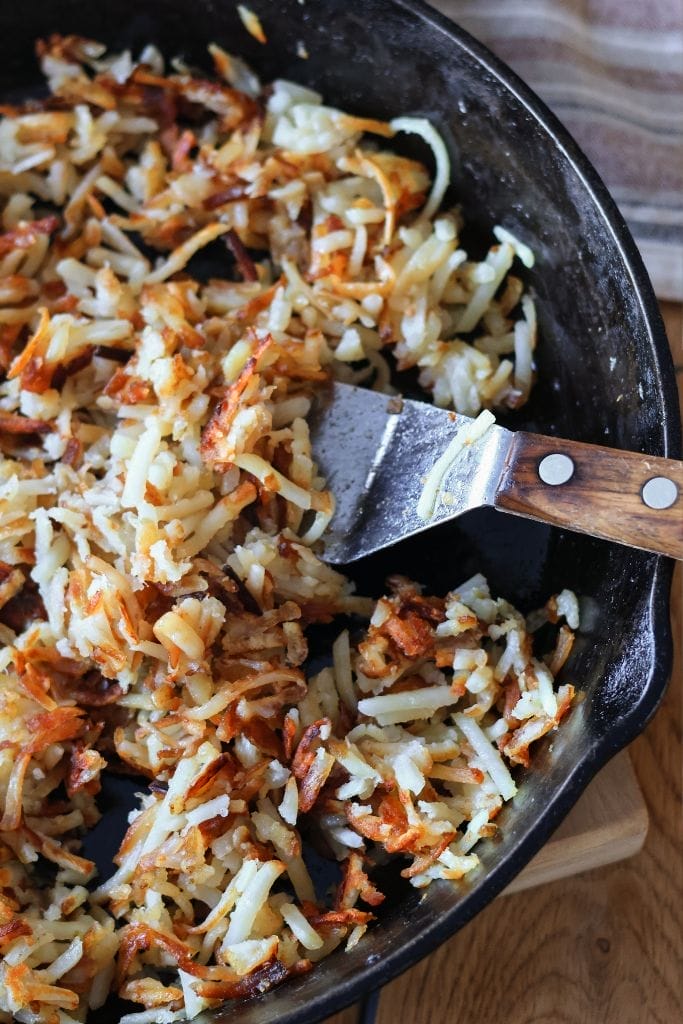
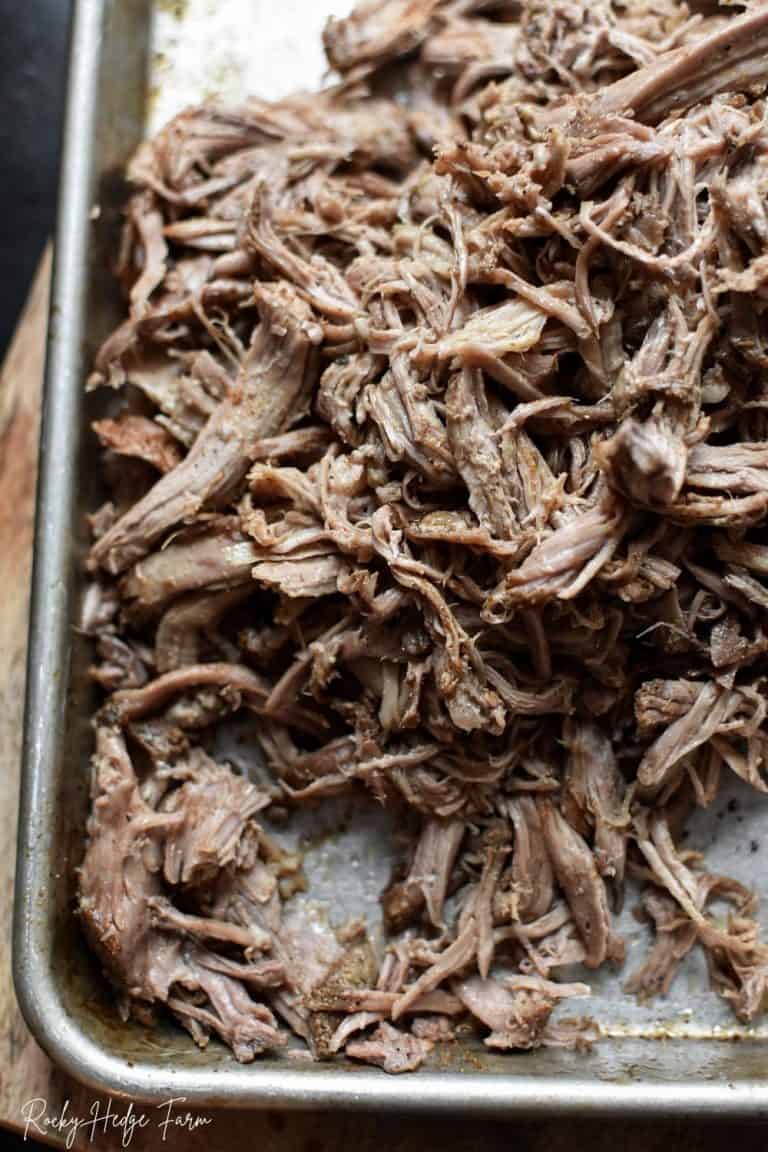
I am wondering about your rack that your pans are hanging from. Where can I get one?
Thanks!
Hey! Thanks for asking, you can find that here: https://www.rockyhedgefarm.com/how-to-store-cast-iron-pans